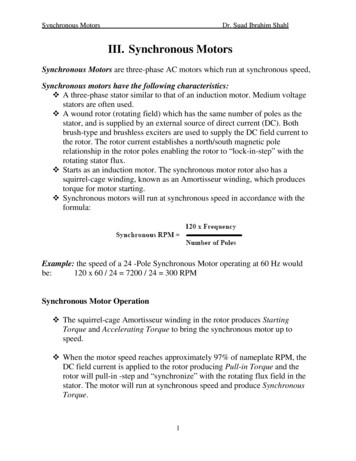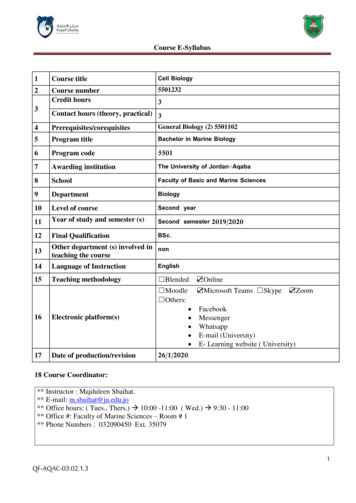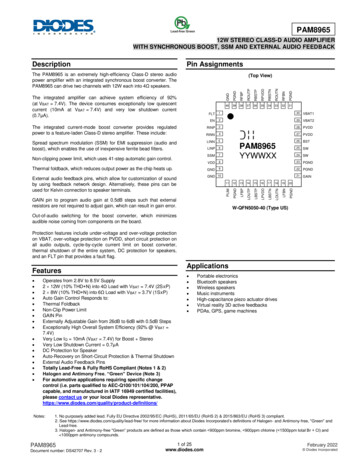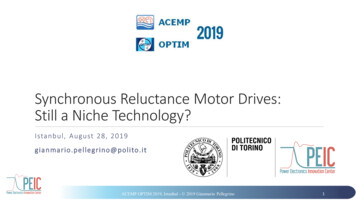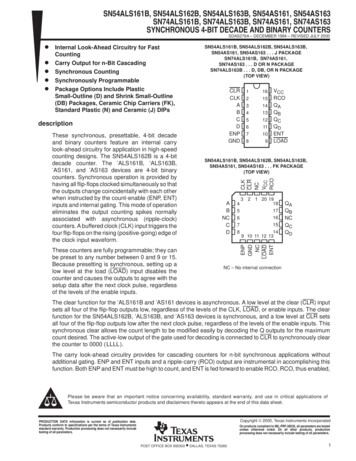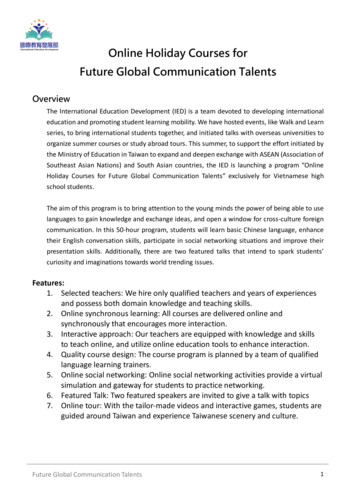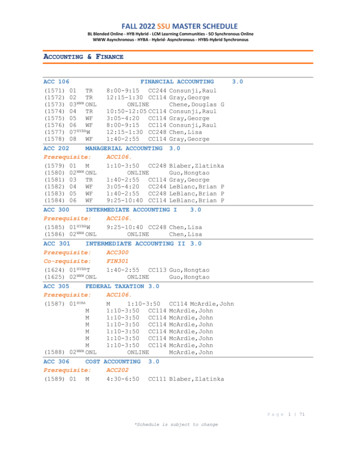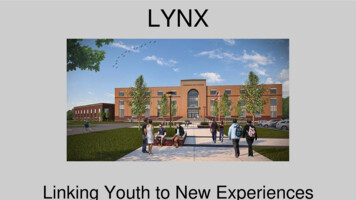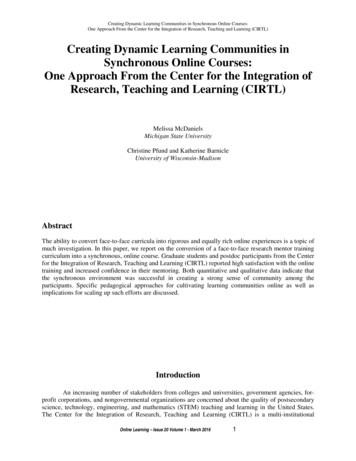
Transcription
Creating Dynamic Learning Communities in Synchronous Online Courses:One Approach From the Center for the Integration of Research, Teaching and Learning (CIRTL)Creating Dynamic Learning Communities inSynchronous Online Courses:One Approach From the Center for the Integration ofResearch, Teaching and Learning (CIRTL)Melissa McDanielsMichigan State UniversityChristine Pfund and Katherine BarnicleUniversity of Wisconsin-MadisonAbstractThe ability to convert face-to-face curricula into rigorous and equally rich online experiences is a topic ofmuch investigation. In this paper, we report on the conversion of a face-to-face research mentor trainingcurriculum into a synchronous, online course. Graduate students and postdoc participants from the Centerfor the Integration of Research, Teaching and Learning (CIRTL) reported high satisfaction with the onlinetraining and increased confidence in their mentoring. Both quantitative and qualitative data indicate thatthe synchronous environment was successful in creating a strong sense of community among theparticipants. Specific pedagogical approaches for cultivating learning communities online as well asimplications for scaling up such efforts are discussed.IntroductionAn increasing number of stakeholders from colleges and universities, government agencies, forprofit corporations, and nongovernmental organizations are concerned about the quality of postsecondaryscience, technology, engineering, and mathematics (STEM) teaching and learning in the United States.The Center for the Integration of Research, Teaching and Learning (CIRTL) is a multi-institutionalOnline Learning – Issue 20 Volume 1 - March 20161
Creating Dynamic Learning Communities in Synchronous Online Courses:One Approach From the Center for the Integration of Research, Teaching and Learning (CIRTL)network of research institutions committed to improving the quality of teaching in postsecondaryeducation (www.cirtl.net). This network is funded by the National Science Foundation (NSF) andspecifically supports the professional development of graduate students and postdoctoral fellows acrossthe country. The professional development opportunities made available to network participants includecampus-based workshops, network-wide in-person conferences, on-campus teaching fellowships, and aseries of online professional development discussions, webinars, and courses on research mentoring,course design, teaching in a diverse classroom, and other topics of great interest to CIRTL members.In this paper, we chose to focus our research questions on the learning and professionaldevelopment outcomes for several classes of students who took one of the network’s synchronous onlineprofessional development courses (on the topic of research mentoring). In the paragraphs that follow, weexplore answers to the following question: Can we convert a successful face-to-face professionaldevelopment curriculum into a rigorous and equally rich online experience for graduate students andpostdocs in such a way that maintains participant satisfaction, confidence, learning, and a sense ofbelonging to a learning community?We start by grounding this question in the literature of online learning in general and synchronousonline learning specifically. We then describe the course and the network that served as the context forour inquiry. This description will include an overview of the CIRTL Network’s conceptual foundation,goals, and activities; the history of the Research Mentor Training (RMT) curriculum; and the process thatwas undertaken to translate the RMT curriculum from a face-to-face to an online context. Next, weprovide an overview of the method we utilized in this investigation and an overview of the findings,ultimately answering our research question (articulated above). The paper ends with implications forinstruction and for further research.Literature ReviewBoth the design of and research about this course took into account research about the efficacy ofonline learning in postsecondary higher education, as well as research about the characteristics of goodteaching in face-to-face settings (which are applicable to an online context). As is detailed in the Methodsection of this paper, the course at the focus of this inquiry began as a very successful face-to-facetraining program. Prior to being offered online, over 650 people attended 8–10 hours of RMT at both theUniversity of Wisconsin–Madison and at other institutions across the country. In order to feel comfortablewith developing a version of the RMT curriculum for an online audience, the instructors/coursedevelopers needed to be committed to debunking some of the myths about online education. Critics of thequality of online educational experiences often say online learning is impersonal, not rigorous, marked bylearning distractions, not able to support group work, void of affective communication, and vulnerable tothe health of the technologies needed to house such courses (DeMaria & Bongiovanni, 2010).In designing the online version of the course, the faculty members took into consideration whatresearchers found to be important factors that influence the success of online learning experiences.Researchers found that three key factors contribute to high-quality online learning environments (Swan etal., 2000). First, the quality of the instructional interface must be transparent and of high quality. As within-person classes, students must feel comfortable with and know how to locate necessary learning tools inthe online interface. Second, any online course needs to have an interactive, high-quality instructor. Inthis case, the faculty knew that their approach to teaching online needed to make students feel connectedto them and each other. Students needed to feel welcomed, encouraged, and guided, just as they would ina face-to-face class. The faculty also knew that they must be prepared to model the communicationstrategies they wanted their students to utilize with their peers. Third, the faculty knew that the instructionOnline Learning – Issue 20 Volume 1 - March 20162
Creating Dynamic Learning Communities in Synchronous Online Courses:One Approach From the Center for the Integration of Research, Teaching and Learning (CIRTL)had to be dynamic, and discussions among students and faculty needed to be both authentic and valuable.The importance of these factors in building community is highlighted by Swan et al. (2000):It is our belief that this combination of factors is not an accident, but rather that they jointlysupport the growth of . “knowledge building communities.” We agree with many in the onlineeducation field that the development of such communities is critical to the success of onlinecourses. (p. 379)The faculty members then needed to decide whether the online version of this course would beoffered in a synchronous, asynchronous, or hybrid format. Synchronous learning involves students andfaculty members interacting with each other in real time, just as they would in a face-to-face course.Asynchronous learning, on the other hand, occurs even when participants and instructors are not online atthe same time. Of course, decisions about which of these models to use should depend upon the desiredlearning outcomes for a particular course. After Hrastinski (2008) performed an analysis of thecommunication threads of a course he was teaching, he found that content-focused language was mostoften found in asynchronous courses. He found that rhetoric focusing on task planning and/or socialsupport appeared more often in synchronous classrooms. This course was composed primarily ofsynchronous online learning because of the complexity of the issues being discussed, the important rolethat community building played in the desired outcomes and processes in the course, the reliance on highstudent motivation for course success, and the level of demands we put on the students to work togetheron tasks (e.g., case studies). Each of these factors was identified by Hrastinski (2008) as being particularlyamenable to synchronous online learning environments.In a pilot study of synchronous learning with nursing students, Little, Passmore, and Schullo(2006) noted the importance of starting with a clear but flexible lesson plan and supporting interactionamong students during synchronous sessions, including making use of the hand-raising tool andinterspersing activities throughout the synchronous session. Students in the nursing course noted that thesynchronous tools “helped bring group cohesion to the class” (p. 322). The authors noted that oft-usedface-to-face activities could be adapted to the online format, including active and cooperative learningactivities.McBrien, Jones, and Cheng (2009) found that, despite some technical difficulties, students inthree graduate and three undergraduate courses reported a positive experience taking a synchronouscourse. However, some students were overwhelmed by the multiple simultaneous forms of interaction.These authors reminded faculty to remain vigilant and proactive in managing interaction during the realtime sessions. Students in the McBrien et al. study also expressed a need for a clear and consistentstructure in the virtual setting. LeBlanc and Lindgren (2013) noted the importance of building communitywithin online language courses. The use of webcams allowed their students to see nonverbal cues, andfaculty at their institution made sure that students introduced themselves at the start of the course and hadthe opportunity to provide timely feedback on the structure of the course during the semester.The knowledge generated from this previous work formed the conceptual foundation for ourapproach to translating the research mentoring curriculum for the online context.MethodCourse Context and StructureCIRTL Network. The RMT course is offered through CIRTL Network. The CIRTL Network iscollaboration among 22 public and private research universities from across the United States. EachOnline Learning – Issue 20 Volume 1 - March 20163
Creating Dynamic Learning Communities in Synchronous Online Courses:One Approach From the Center for the Integration of Research, Teaching and Learning (CIRTL)member institution is committed to improving the education of undergraduate students studying STEM bybetter preparing future STEM faculty to teach. Together, the 22 universities that make up the CIRTLNetwork graduate over 20% of the individuals who earn STEM doctorates in the United States each year.Many of these individuals go on to become faculty members teaching undergraduate students atcommunity colleges, liberal arts colleges, and comprehensive universities as well as research universities.CIRTL works to improve the teaching skills of future faculty so that they are better prepared to help theirstudents learn.CIRTL Core Ideas. The overarching goal of CIRTL is to increase the quality of STEM learningof all undergraduate students, thereby contributing to increasing the number and diversity of thoseindividuals working in STEM fields. Three core ideas infuse CIRTL programs: Teaching-as-Research (TAR) is the deliberate, systematic, and reflective use of research methodsby STEM instructors to develop and implement teaching practices that advance the learningexperiences and outcomes of all students.Learning communities (LC) bring together groups of people for shared learning, discovery, andgeneration of knowledge. To achieve common learning goals, a learning community nurturesfunctional relationships among its members.Learning-through-Diversity (LtD) capitalizes on the rich array of experiences, backgrounds, andskills among STEM undergraduates and graduates through faculty to enhance the learning of all.It recognizes that excellence and diversity are necessarily intertwined.CIRTL goal and approach. The goal of CIRTL is to prepare STEM graduate students andpostdocs to become faculty who use and improve best practices in STEM teaching and learning withattention to diverse student audiences. CIRTL works to achieve this goal by (1) establishinginterdisciplinary learning communities across and within a network of universities, each founded on theCIRTL Core Ideas, and (2) establishing a scalable cross-network learning community such that futurefaculty are better prepared for successful teaching careers as a consequence of the network’s diversity,and such that institutional members benefit from the shared expertise in future faculty development acrossthe CIRTL Network.CIRTL Network activities. During the 2013–14 academic year, CIRTL member institutionscollectively offered over 100 local teaching and learning professional development programs. Theseprograms included courses, workshop series, cohort-based seminar series, and opportunities for graduatestudents and postdoctoral fellows to participate in TAR experiences. Opportunities ranged from singleevents to series with over a dozen meetings throughout the academic year. Together, attendance at theseevents exceeded 4,000. While some individual programs are located within a particular department ordiscipline, the vast majority of CIRTL programs are interdisciplinary, involving students and faculty fromseveral STEM and social and behavioral sciences (SBE) departments. All of CIRTL’s cross-networkonline programs are interdisciplinary and interinstitutional. Graduate students and postdocs from memberinstitutions who are in a STEM, SBE, or a STEM-education field may participate in CIRTL courses. Thisinterinstitutional format allows participants to benefit from the diversity and collective experiences ofclassmates at different universities. Participants in CIRTL courses bring a wide range of experiences,backgrounds, and perspectives, including experiences unique to their graduate program and institution.The course that is the subject of the inquiry in this paper (Research Mentor Training) was first offeredonline to CIRTL students in the fall of 2010, as one of two online CIRTL courses offered that semester.Since that time, CIRTL’s cross-network learning community and the number of online course offeringshave grown considerably. In 2014, the online curriculum included 16 full and short courses, including line Learning – Issue 20 Volume 1 - March 20164
Creating Dynamic Learning Communities in Synchronous Online Courses:One Approach From the Center for the Integration of Research, Teaching and Learning (CIRTL)Face-to-Face Research Mentor Training course. The central question we pose in this paper isthis: How can a successful face-to-face professional development curriculum be converted into a rigorousand equally rich online experience for graduate students and postdocs in such a way that maintainsparticipant satisfaction, confidence, learning, and a sense of belonging to a learning community?Research Mentor Training curriculum history. RMT offered through the CIRTL Network isbased upon the Entering Mentoring (EM) curriculum (Handelsman, Pfund, Miller, & Pribbenow, 2005)and was designed to improve the effectiveness of mentors working with undergraduates. Publishedevaluation of EM indicates that mentors who participate in training are more likely to consider issues ofdiversity, discuss expectations with their mentees, and to seek the advice of their peers. EM(www.researchmentortraining.org) has since been adapted and enhanced for use across STEM fields aswell as within medicine and public health, for mentors and mentees at various career stages (Pfund et al.,2006; Pfund et al., 2013; Sorkness et al., 2013; https://mentoringresources.ictr.wisc.edu). Results from arecent randomized, controlled trial using an EM-based curriculum at 16 sites indicate the effectiveness ofthe approach for both mentors and their mentees (Pfund et al., 2013; Pfund et al., 2014).The EM curriculum uses a process-based approach to introduce core mentoring competencies,experiment with various mentoring strategies, and provide a forum to solve mentoring dilemmas withsmall peer groups. Training sessions are typically offered as a series of interactive one-hour sessionsfacilitated by one or two faculty, staff, or postdocs. The six competencies from the EM-based curriculaare (1) maintaining effective communication, (2) establishing and aligning expectations, (3) assessingmentees’ understanding of scientific research, (4) addressing diversity within mentor–menteerelationships, (5) fostering mentees’ independence, and (6) promoting mentees’ professional careerdevelopment.Online Research Mentor Training course. In 2010, a multidisciplinary version of the EMcurriculum was adapted for use in online courses to mentors across the nation through the CIRTLNetwork. This course was intended to be primarily synchronous, with a few asynchronous elements. Thecourse was structured to allow students to achieve the goal of leaving the class with a similar set oflearning outcomes to students who took the face-to-face course. The developers believed that students’ability to achieve this outcome would depend upon a set of key choices regarding the “space” for thesynchronous classes and asynchronous work, as well as explicit pedagogical choices to ensure thedevelopment of a rich learning community in an online setting.Where were the synchronous class sessions held? Regardless of where synchronous learningtakes place (face-to-face or online), instructors need to ensure that the space where learning will takeplace has the resources and accessibility needed for high-quality instruction. We utilized BlackboardCollaborate (formerly Elluminate) as our virtual classroom. Because a primary goal was to create a senseof community among the learners, despite the physical distance between participants, several factors wereconsidered when selecting a technology to host the synchronous class sessions. Desirable basefunctionality for the virtual classroom included cross-platform compatibility and accessibility for users ofassistive technology. It was important for students to be able to participate using a variety of operatingsystems and browsers. However, it was the interactive features of the classroom itself that were ofparticular interest. Though technology was changing at a rapid pace, virtual classrooms in 2009 and 2010still had some limitations. For the CIRTL Network courses, several available online-learning featureswere deemed critical, including support for direct audio and video interactions. Many students connectedto class from laboratories or other spaces on campus where there was no access to a landline phone orpoor cell phone reception. The virtual classroom needed to facilitate hand raising, support text chat, someform of document or application sharing as well as a polling feature to gather responses from students.Finally, support for virtual breakout rooms with whiteboards was weighted heavily during the process ofselecting course tools, as the use of small group discussions is a core pedagogical approach used in RMT.Online Learning – Issue 20 Volume 1 - March 20165
Creating Dynamic Learning Communities in Synchronous Online Courses:One Approach From the Center for the Integration of Research, Teaching and Learning (CIRTL)Students were also asked to create Skype accounts to serve as a backup method of contacting theinstructor (should they have trouble connecting to Blackboard Collaborate) as well as for one-to-oneinteractions with classmates outside of class.Where did the asynchronous learning take place? We chose the Moodle course managementsystem (CMS) to provide the basic information-sharing functionality used in many courses. We used thisCMS system to share the course syllabus, readings, and assignments. We also used the CMS system tosupport the learning community among participants. Students posted brief biographical sketches andphotos during the first week of class. These profiles helped students get to know each other. Throughoutthe course, Moodle was also the place where students posted interesting articles to share with their peersand instructors. E-mail was of course another asynchronous strategy used to connect the students with theinstructors and with each other.What pedagogical choices were made to maximize student learning? Successful use of anysynchronous online learning system requires thoughtful pedagogical choices on the part of the instructors.Our goal was to make technological choices that supported our pedagogical goal of building a sense ofcommunity in the online space. These choices included patiently waiting for people to turn on theircamera and audio; stressing the importance of using video when speaking; making use of breakout roomsthat allowed everyone to use video simultaneously; utilizing whiteboard space to have everyone shareideas and responses to questions; encouraging students to use the emoticon, thumbs-up, and thumbs-downfunctions to solicit feedback about student understanding; and reminding students to use the chat windowto pose questions or add ideas at any time. Table 1 provides a more detailed overview of how approachesused for teaching RMT in a face-to-face context were adapted to work in the synchronous andasynchronous online contexts.In addition to making pedagogical choices that took advantage of the technology, we madechoices that we would make in any face-to-face setting. Most of these choices took advantage of andemphasized the importance of the learning community. Throughout the course, the instructors reiteratedthat the primary goal of the seminars was to establish a learning community focused on the improvementof mentoring practices. We discussed elements of constructive and destructive group dynamics, how towork well in groups, and the importance of participation and confidentiality. We implemented processesof peer review of mentor–mentee compacts and mentoring philosophies, allowing participants to seeexamples of these compacts, with the aim of fostering collaboration and cooperative learning. Finally, weset the expectation that those who were absent from class would still send their responses to a case studyor provide thoughts on the reading so that the larger group didn’t miss out on hearing their ideas.Table 1Conversion of Pedagogical Approach From Face-to-Face to Synchronous Online SettingApproach used inface-to-faceclassroomApproach used in synchronous online classroomIntroductions aroundthe roomStudents take turns turning on their camera and microphone and introducingthemselves to the group.Visual presence inevery sessionStudents take turns turning on their camera and microphone and saying helloeach week.Online Learning – Issue 20 Volume 1 - March 20166
Creating Dynamic Learning Communities in Synchronous Online Courses:One Approach From the Center for the Integration of Research, Teaching and Learning (CIRTL)Mini-lecturePowerPoint slides are shared on the whiteboard, and instructor “lectures” usingaudio and video.BrainstormingStudents all write their ideas simultaneously on a shared whiteboard.Small groupdiscussion and reportoutStudents work in small groups in separate breakout rooms with audio and video;they record their ideas on the whiteboard in their breakout room, which is thenshared with the larger group during a report-out session.Case studiesA case study is posted on the whiteboard, and students work in small groups inbreakout rooms (see above) or in a large group to answer questions about thecase. Students can share their ideas using audio and video or using the chatroom.Think-Pair-ShareStudents work in pairs in separate breakout rooms with audio and video; theyrecord their ideas on the whiteboard in their breakout room, which is then sharedwith the larger group during a report-out session.Large groupdiscussionStudents share their ideas using audio and video with the large group. Studentsare asked to raise their hand if they wish to share or type their ideas in the chatroom window.Question and answerStudents are encouraged to raise their hand using the hand-raising feature to askor answer a question. Alternatively they can ask or answer a question in the chatroom window.ClickersStudents are asked to use their keyboard to respond to polling questions (yes/no,multiple-choice). Answers are displayed for all to see.Peer reviewStudents can review other students’ materials outside class and then meet withthem in breakout out rooms to share feedback.Quick check-insStudents were asked to use the emoticon to show how they were doing or if theyunderstood the material. These include a smiling face, frowning face, thumbs up,or thumbs down.ParticipantsDemographics. A total of 44 graduate students and postdocs took the course in the fall 2010, fall2012, and spring 2014 semesters. Of these participants, 39 responded to the surveys (for an overallresponse rate of 88.6%). These respondents represented 17 different institutions in the CIRTL Network(see Table 2 for a comprehensive list of institutions in the CIRTL Network). Eighteen of the participantswere graduate students, 19 were postdocs, and 2 did not identify their training level. Of the surveyrespondents, 23 identified as female and 16 identified as male. The racial/ethnic makeup of the group was62% White (24 participants), 5% African American (2), 8% Hispanic/Latino (3), and 18% Asian/PacificIslander (7), and 8% identified as members of more than one racial/ethnic group (3). The instructors ofthe RMT course included three individuals from three different CIRTL institutions. All three were whitefemales who held academic staff/instructor positions at their home institutions and were each engaged inteaching, learning, and research initiatives.Online Learning – Issue 20 Volume 1 - March 20167
Creating Dynamic Learning Communities in Synchronous Online Courses:One Approach From the Center for the Integration of Research, Teaching and Learning (CIRTL)Table 2CIRTL Network Institutional ParticipantsBoston UniversityCornell UniversityHoward UniversityIowa State UniversityJohns Hopkins UniversityMichigan State UniversityNorthwestern UniversityTexas A&M UniversityUniversity of GeorgiaUniversity of Texas at ArlingtonUniversity of Alabama at BirminghamUniversity of California, San DiegoUniversity of Colorado at BoulderUniversity of HoustonUniversity of Maryland, College ParkUniversity of Massachusetts AmherstUniversity of Missouri–ColumbiaUniversity of PittsburghUniversity of RochesterUniversity of Wisconsin–MadisonVanderbilt UniversityWashington University in St. LouisExperience with technology. The majority of our participants had some experience withsynchronous learning technologies that served as the foundation for CIRTL online courses such as RMT.Over 75% of the participants had experience engaging others via online chat channels (e.g., AIM, IM),voice over IP services (e.g., Skype), video and audio conferencing, or use of emoticons in onlinecommunication. This familiarity is not surprising given the ubiquity of these tools in casual and personalonline communication. Participant experiences with online technology in a formal educational settingwere much more limited. Only 27% of participants had experience with virtual, synchronous onlineclassrooms (e.g., Blackboard Elluminate); 33% of participants had experience using asynchronous onlineclassrooms; and 24% had experiences using an electronic whiteboard.Figure 1. Percentage of participants indicating prior experience with various forms of technology used inthe online Research Mentor Training course (n 37–39).Online Learning – Issue 20 Volume 1 - March 20168
Creating Dynamic Learning Communities in Synchronous Online Courses:One Approach From the Center for the Integration of Research, Teaching and Learning (CIRTL)Background and Preparation of Course FacultyAll of the RMT course instructors were experienced facilitators and were skilled in utilizingactive learning strategies with undergraduates, graduate students, postdocs, and/or faculty. One of theinstructors (Pfund) is an original developer of Entering Mentoring, the face-to-face version of RMT, andwas primarily responsible for adapting the course for the synchronous, online version. This instructor hadher first experience teaching in a synchronous, online environment in 2009, co-leading a different CIRTLNetwork course. This instructor was one of the co-instructors in each of the three RMT offeringsdescribed in this paper. Both other instructors had some familiarity with the Entering Mentoringcurriculum and had taught elements of RMT before teaching the online version. One of these instructorshad previous experience teaching an asynchronous online course, while the other instructor had no priorexperience teaching in an online venue. Prior to teaching the RMT course, detailed facilitator notes wereprepared for each session. These notes were based on the facilitator notes previously created andpublished for Entering Mentoring and adapted for the synchronous/asynchronous, online environment.Co-facilitators met for 30–60 minutes prior to each session (1) to review the prior session and discussneeds for improvement, (2) to discuss the facilitator notes and the course material, and (3) to discuss thepotential challenges that might arise with the technology. In these meetings, the co-facilitators alsodecided who would lead each part of the session. Importantly, the person not in charge of leading anactivity or discussion was assigned the task of monitoring the chat window, addressing any questions, andnavigating any technical issues, if they arose.SurveyIn order to answer our research question, we designed a survey and collected data from onlineRMT participants—graduate students and postdocs—after the course was completed in fall 2010, fall2012, and spring 2014. Participants received an e-mail link on the last day of class, inviting them to takean electronic survey. After providing some
Online Learning - Issue 20 Volume 1 - March 2016 . 1 . Creating Dynamic Learning Communities in Synchronous Online Courses: One Approach From the Center for the Integration of Research, Teaching and Learning (CIRTL) Melissa McDaniels . Michigan State University . Christine Pfund and Katherine Barnicle . University of Wisconsin-Madison . Abstract

